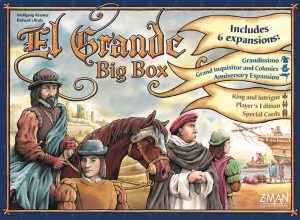El Grande Board Game Review

By MARK WILSON

Year Published: 1995
Players: 2-5
Playing Time: 90 Minutes
El Grande Gameplay
Spain sets the stage for a sprawling game of maneuvering and area control. In each of nine rounds, 2-5 players jockey for one of five cards available in the round that allow them to place a certain number of meeples on the board and perform a special action, in either order. Both meeples and actions help to secure various regions on the board, which are all scored after rounds 3, 6 and 9. The Castillo acts as a sort of mystery castle, with players able to drop meeples (or cubes in some editions) into it, announcing how many they’re dropping. But you can’t look inside, so if you forget if you dropped three or four, you’re out of luck. The Castillo scores first, then those meeples are moved to the board proper and scoring takes place.
The actions vary wildly, but all represent tactical possibilities. Several – by necessity of how you score points – will be at the expense of others.
The Components
For reference, I own the “Big Box” edition. I can’t count the number of times I’ve seen people say El Grande’s board is bland. These people are wrong, at least as much as anyone can be about something that’s obviously subjective. It’s a cool map.
The meeples/cubes are all fine. The “King” (which looks suspiciously like…something else that I won’t name) is amusing and large. Lastly, the three-dimensional Castillo is great, an imposing tower overlooking the proceedings.
Focused Area Control
How many modern games are hybrids of multiple mechanics and ideas? I think the answer is approximately 11, which is the highest my brain can count right now (it’s really early as I’m writing this). If numbers go higher than 11, that’s how many. In any case, it’s a lot. I think area control (which is sometimes called “area majority” or “area influence”) is one of the mechanics that is most susceptible to becoming a hybrid.
El Grande is just area control. I mean, sure, there are actions related to card piles, but it’s all in service of controlling areas. But it’s good area control, it’s delicious area control, and it’s a level of depth and length that it feels like something approximating epic area control.
Interaction is high. Outside the slightly more cloistered (but still contested) Castillo, the whole game is a tug of war in numerous regions between all players. Yet the strategy of it remains the headliner.
Strategy Vs. Tactics
I suppose you could argue that there are long-term strategies in this game, but it’s largely a game of round-to-round tactics. Which card do you want from among the face up options? What card from your personal hand should you play to try to get it? And how do you utilize it best? Rinse and repeat. The formula is a great one, but your mind will usually be in the moment, not able to think more than about one round ahead.
Interaction in El Grande
The action cards can and will hurt your opponents, just as they’ll hurt you, but I want to focus on this for a second to highlight something El Grande does well.
If my opponent screws me over in a region, it hurts, but it’s almost invariably because it’s the move that also helps him the most. This is different than “mean for the sake of mean.” To me, it doesn’t feel like the more arbitrary “take that” mechanics in many games, because each action is deliberate and will maneuver someone into a better tactical position. The fact that every action card can be put to excellent tactical use means that it keeps the focus on the strategic side, not the fact that you have to step over your friends to get to the winner’s circle.
El Grande can be mean, but I think you’d have to go specifically out of your way for it to feel personal. Thus, it avoids the sourness of some games that don’t always give players such rich tactical options.
Players as a Variable
Other older games like Dune and Cosmic Encounter feature something that El Grande has. In it, the actions and options are not always perfectly balanced. Instead, it’s up to the players to provide an element of self-balancing.
The fear is that this results in bashing the leader. In practice, yes, you have to mitigate the leader’s position to avoid them running away, but like the above section, there’s a purpose behind it and you can never ignore your own strategic interests. If an action is only mean and doesn’t help you, it’s almost invariably going to torpedo your own chances more than the rest of the table.
In practice, this means that everyone is keeping an eye on who controls what, and where they might try to expand to or shore up. It’s a way to stay invested during downtime.
Cons to El Grande
I’ve encountered two, and while I’d consider both minor, they’re both worth mentioning.
The first is that lower player counts make the board seem more remote and potentially more cutthroat. The sweet spot is likely at 4-5P. However, at 5P, there can be downtime that’s a bit too long, especially if you have thoughtful (see also: AP-prone) players. Neither is a big deal, but both could be a small deal for some groups.
Second, I’ve never seen a leader run away with the game due to the self-balancing nature of the game. But I have seen 1-2 players fall far enough behind that they’re left with little hope of winning going into the final three rounds. This is a long enough game that this can be a problem. I don’t mind using that time to figure out what I could have done differently, but for some, it may just be time spent waiting for the game to end.
A Note on the Big Box Version
I have read through the expansions in the Big Box and frankly have no desire to use them. The game is fine as-is. However, the Big Box is currently the only version of the game I’ve found that’s in print. Many who I’ve seen talk about this game think that the expansions aren’t necessary. So you may have to pay for stuff you don’t need.
The Big Box is also gigantic, and I really wish it didn’t make the game look so intimidating. People think I’m trying to pitch them a much more intimidating game when I suggest playing it. The sheer size of the box has undoubtedly meant I play it less. It’s a minor inconvenience, but I would have appreciated a non-expansion reprint.
El Grande – Conclusions
El Grande doesn’t really show its age for me. Or rather, it might, but only because it remains more focused than many it inspired. Area control now usually means direct combat and/or hybrid mechanics in addition to the central control elements. El Grande lacks these things, so it—somewhat ironically—fills a weird, underrepresented niche in the genre, despite being the forefather of many modern games.
I also didn’t talk much about it seems almost austere at times compared to many games. This is a feature, though, not a bug. You will have fewer actions than you’re used to taking in such games, but each one can be a potentially momentous decision. “Streamlined” is an overused term in gaming, but I think it applies here. El Grande is the decluttered version of numerous games that I’ve played in recent years, and it’s better off for that fact.
As evidenced by its rating on Board Game Geek, this remains a well-regarded classic that has stood the test of time. Even as stalwarts like Carcassone and Pandemic have fallen out of the top 100, this has held on. That won’t last forever, of course, but it’s still a bit remarkable.
More than anything, though, El Grande feels big and satisfying to me. I love pushing my Caballeros around and trying to out-maneuver my opponents. It’s not without some marginal flaws, but if you enjoy area control, El Grande is a three course, home-cooked holiday meal that will have you loosening your belt and snoring contentedly on the family couch once you’re done.
…
For more content, or just to chat, find me on Twitter @BTDungeons, and if you enjoy my work, be sure to subscribe on Youtube!
Share
Recent Posts
Categories
- All (350)
- Announcements (4)
- Board Games (203)
- DMing (28)
- Game Design (16)
- Playing TTRPGs (22)
- Reviews (189)
- RPGs (142)
- Session Reports (91)
- Why Games Matter (9)